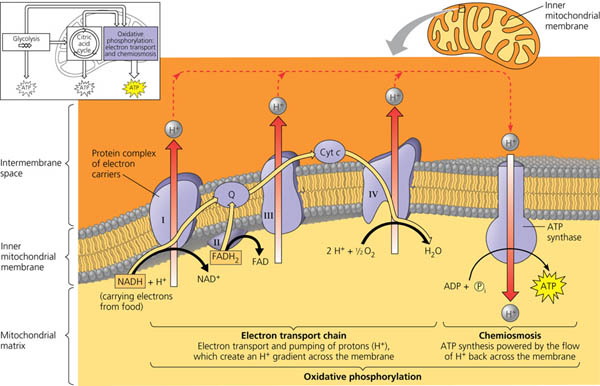 |
| Previous Image | Next Image |
| Description: NADH and FADH2 shuttle high energy electrons extracted from food during glycolysis and the citric acid cycle to an electron transport chain built into the inner mitochondrial membrane. The yellow arrow traces the transport of electrons, which finally pass to oxygen at the downhill end of the chain, forming water. As Figure 9.13 showed, most of the electron carriers of the chain are grouped into four complexes. Two mobile carriers, ubiquinone (Q) and cytochrome c (Cyt c), move rapidly along the membrane, ferrying electrons between the large complexes. As complexes I, III, and IV accept and then donate electrons, they pump hydrogen ions (protons) from the mitochondrial matrix into the intermembrane space. (Note that FADH2 deposits its electrons via complex II and so results in fewer protons being pumped into the intermembrane space than NADH.) Chemical energy originally harvested from food is transformed into a proton-motive force, a gradient of H+ across the membrane. The hydrogen ions flow back down their gradient through a channel in an ATP synthase, another protein complex built into the membrane. The ATP synthase harnesses the proton-motive force to phosphorylate ADP, forming ATP. The use of an H+ gradient (proton-motive force) to transfer energy from redox reactions to cellular work (ATP synthesis, in this case) is called chemiosmosis. Together, electron transport and chemiosmosis compose oxidative phosphorylation
Picture Stats: Views: 10841 Filesize: 53.13kB Height: 386 Width: 600 Source: https://biology-forums.com/index.php?action=gallery;sa=view;id=5797 |
